The Home Run
Semester 2 / Week 7 - 13
Initial Thoughts
After discussion through feedback during the WIP show and a recent tutorial with Paul, I think I am confident to pursue the final piece. The feedback was to consider the formality of it and the clarity of sounds (not being too muddy…).
I would like to make a sound artwork of “scattered” speakers. These speakers would be different, almost like a collection of different species of speakers in a biome. Monitors, subwoofers, desktop speakers, headphones… I would like to connect them up to play found recorded sound from different locations. I want them to almost chat to each other and be linked. I am imagining a single power cable coming down from above into the centre, with the innards showing (the Mac, the audio interface, the wires..). This can be inferred as it as an entity or ecosystem being run on it’s own, with only one power cable provided.
This reminded me very much of an installation at Sonica 2024 at the CCA called Umweltraum((a)) by Sonia Killmann and Laura Mannelli. They created artifical creatures that react with sound.
I had worked on a p5js prototype/sketch a year ago that consists of connections and nodes and travellers that can navigate a network and play sound with triggers. This generated sounds in an almost organic way. There were patterns but it also couldn’t really be predicted.
Sketch
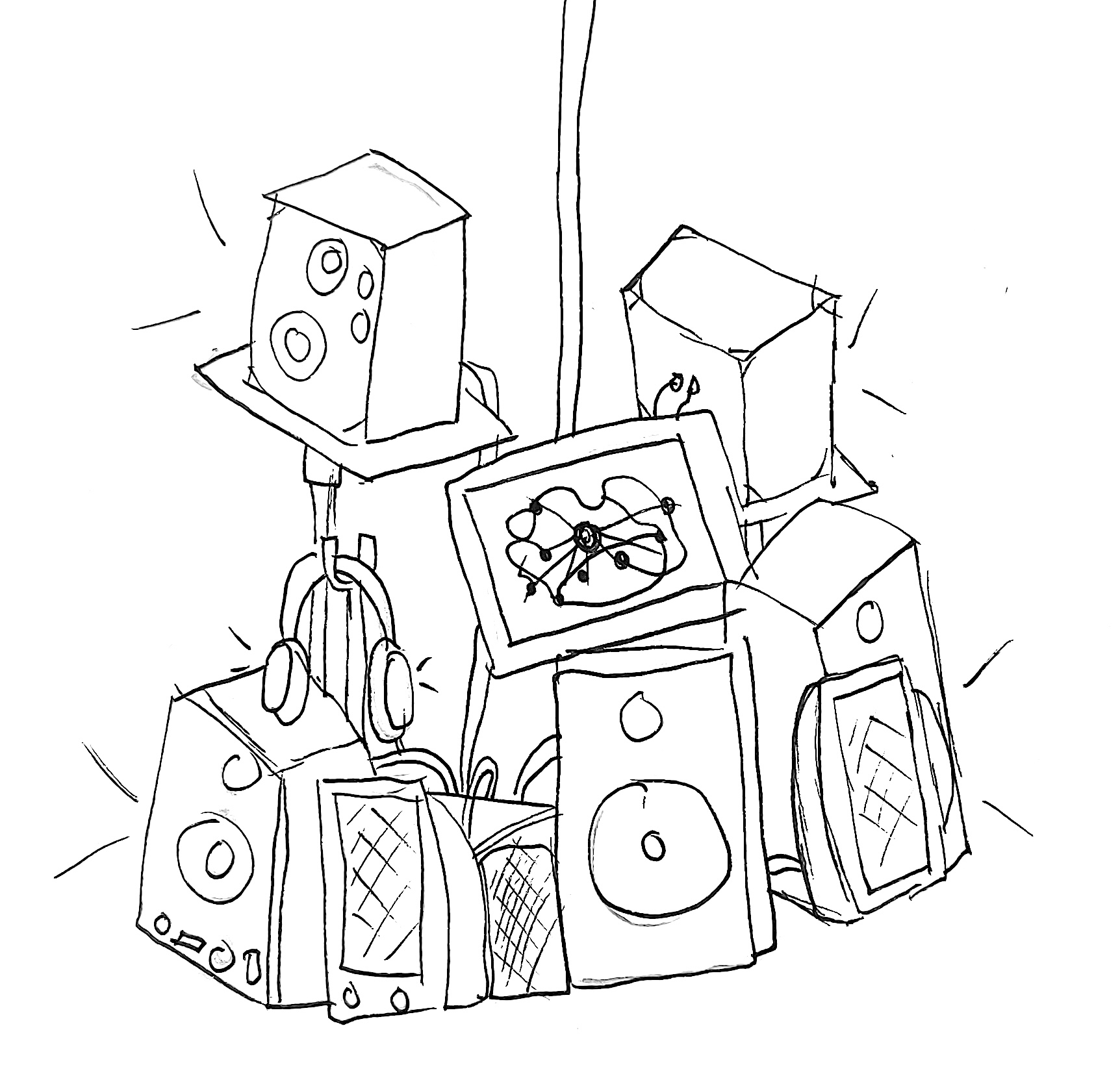
A collection of different speakers bundled together that create sound from the node system I explained above.
Diagram
I went on Gumtree to see what they had to offer on speakers, and found a set of desktop speakers and subwoofer for £10. This reminded me of the home family computer speakers.
On facebook marketplace, I found a TV Soundbar for free to also took that.
I created this diagram to make it clear to me how everything connects.
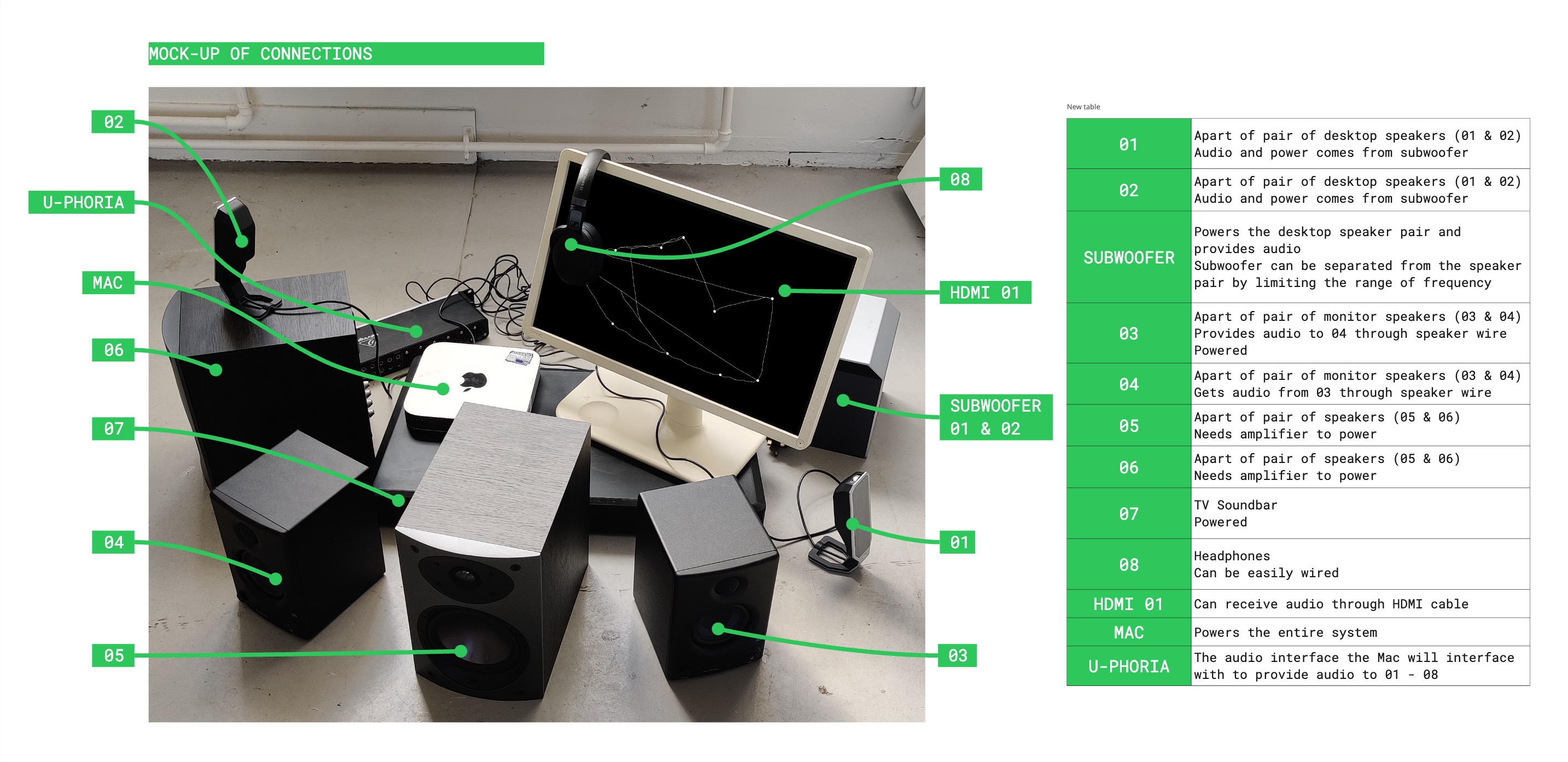
Developing
I developed the program further, converting my p5js project into Java. I added numerous more things that weren’t there before, like simplifying how to use the software through use or more classes (like bundled Node class). I also created line connections that feel organic and that aren’t straight. I used trigonometry for this (trying hard to remember school!), but I figured it out. This allows lines to follow perlin noise and I can alter it however I like.

Sound Capture / Ideas
Idea 1
I wanted to assign specific sounds to each speaker/speaker set that I record from different places around Glasgow. This’ll support the idea of it being an ecosystem that lives and speakers to one another.
I went to my local park (which is quite an important place for me) and recorded for an hour with headphones on. I was interacting with lots of different objects to create sounds in different ways. I used a microphone that lets me mark positions in the recording, which will make it easier to parse it.
For my WIP, I recorded long audio and split it up and played it back randomly. I am going to experiment with how to parse the recorded audio. I may enforce limits on myself to make it easier. Perhaps 50 1 second audio clips from each location. I think this could be quite effective as it’ll enhance the “it’s being digitally played back” feeling. I could even put a gentle bit crush on it or downgrade the sound. The short clips could almost be like chirps sent between them.
Idea 2
Another idea is to develop the idea of “An Array of Floating Ears”. I imagine it as a 2D array, with first dimension as index of ear location, and second as time.
At random slow intervals, the “location” could change and each speaker could play a random sector from that “ear”.
Conclusion
I have been thinking, and I still do very much like my original way of picking random parts of a recording to play back.
I want to give the sonic material space. An experiment of Idea 2 worked well. The sounds recordings shifted around, you could hear the different qualities that each clip had on each speaker. This demonstrates the variablity of speakers and how they impact the sound. Doing this also lets one specific sonic clip be explored by the audience in more detail. It isn’t muddy, like the WIP.
I could collect numerous “floating ear” recordings, which it’ll change through randomly and then pan with noise through the travellers. These could be exploratory recordings, or stationary recordings.
Construction
Gillian suggested using scaffolding to create elevate the speakers and equipment from the ground. I do like the idea of this. I drew a sketch of what I had an idea of for this. If this doesn’t work out, plinths could work too.
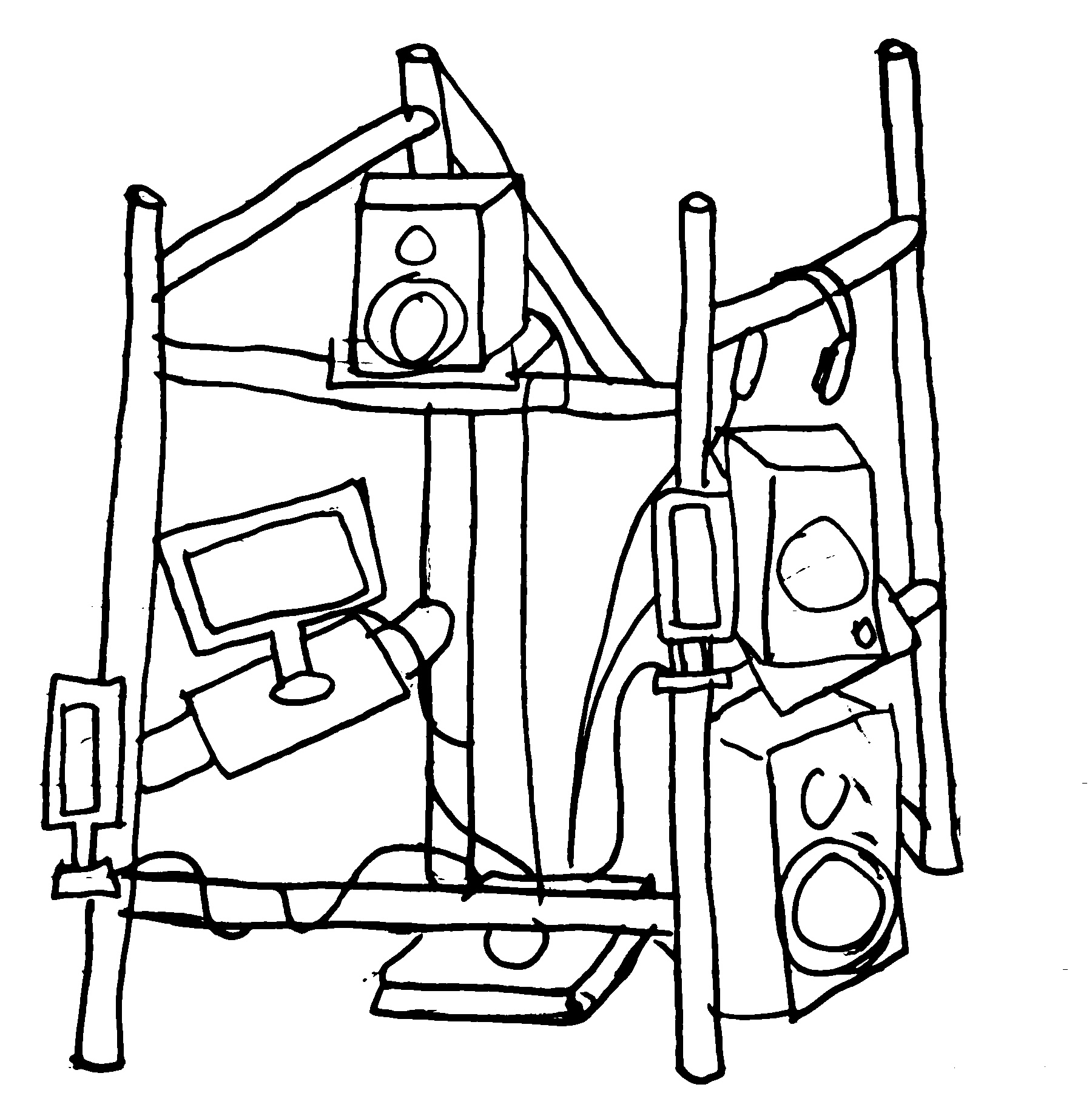
After further discussion, Gillian recommended to use plinths to create a forest-like installation. Here is her sketch:

I do really like the idea of wires hanging between the speakers, almost like trees and vines.
Collecting sounds online
I have had difficulty collecting sounds around Glasgow. It is quite tedious and it’ll take a considerable amount of time to travel between different places to get varied recordings. Also, my microphone, the Zoom H1N, is great at picking some things up but not others.
I thought I could collect sounds online that other people have recorded. These recordings would be across the world and have varying microphones that captured it, enhancing the idea of technical characteristics. The speakers have character and the microphones that capture have character too.
Freesound feels like an obvious choice, most of the sounds recorded seem like hobbiest recordings. They aren’t “pristine” (quote on quote!) like sounds from libraries like Soundsnap. It feels raw. It also feels quite personal.
I was thinking about how I would filter through the mass sound library on freesound.org and I came up with some rules I could follow.
- Only Geotagged sounds
- This means only sounds existing in the world will appear. This should exclude synthesised sounds. I want recordings.
- Minimum 20 seconds
- I need room for the sound to be explored
- Creative Commons 0
- A license where I can do whatever with the sounds. I could use License that requires attirbution, but, I am not entirely sure of the crediting process. Would I only credit on my project webpage?
- Seemingly no edits (except for trimming audio)
I could collect lots of these and then randomise what to use, but, I think I’ll just go through the library and pick lots of different sounds.
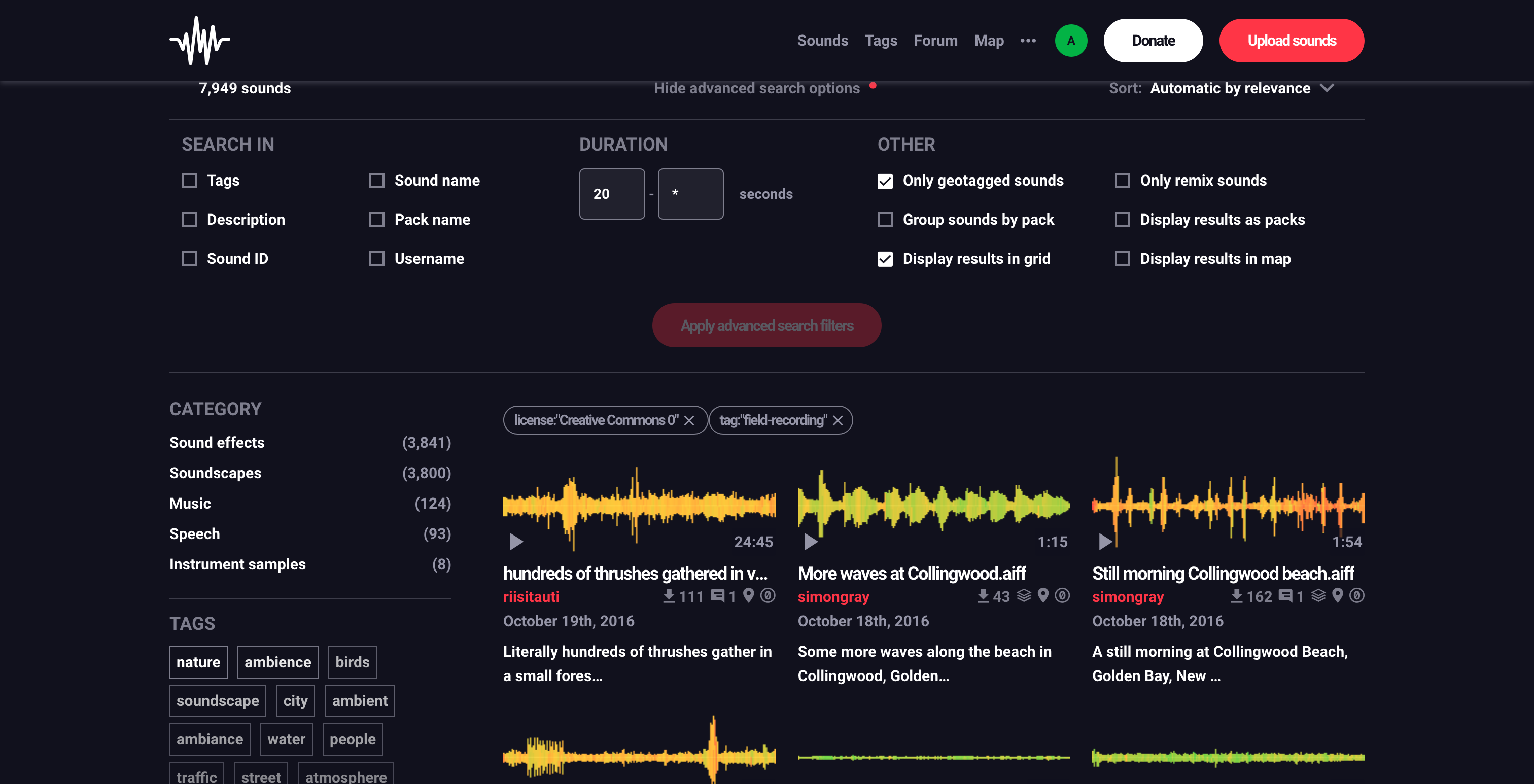
Trimming sounds & loading into Ableton
I loaded the samples downloaded into Ableton and cut them each down to 20 seconds at different positions of the audio. Then I saved these to a folder. After this I loaded the samples into a Sampler and put each sample at a different note.
Setting up
I set up the equipment similar to the vision I got from Gillian’s sketch. I connected it all up so it produces sounds. It was quite effective the way the different sound clips got “scattered” around the speakers.
I asked for feedback from Gillian and she gave:
- Try making it a 360 experience
- Ditch the soundbar
- Explore usage of more monitors.
After consideration and playing around with the setup I have come to these conclusions. I do really like the 360 aspect of setting it up, and ditching the soundbar was a good idea as it was too much a difficult shape and it seemed out of place somewhat. Though, I don’t agree with more monitors, I really like the single monitor and how it’s a singular window into an abstract way of how the system works. I feel more monitors would take over the stage of how different variabilities of sound.
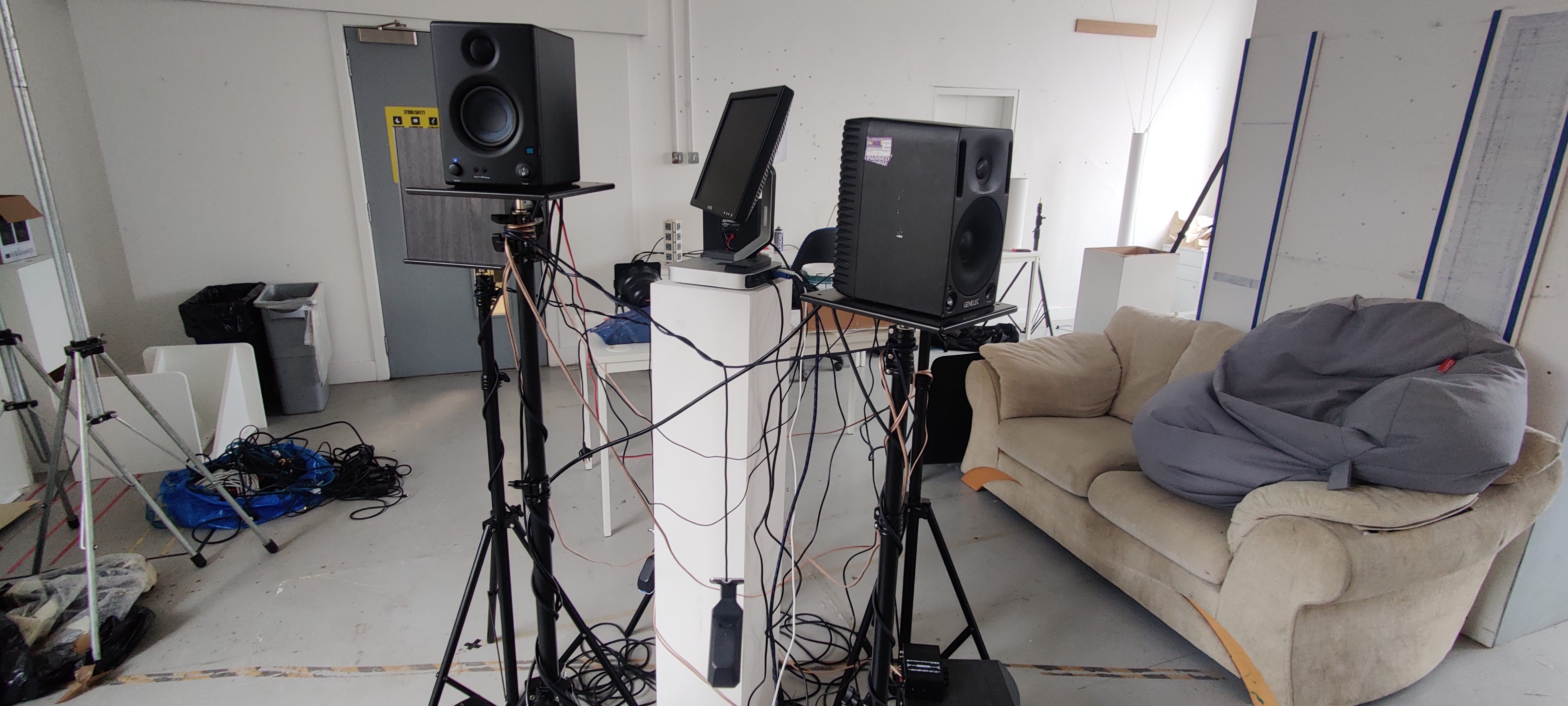
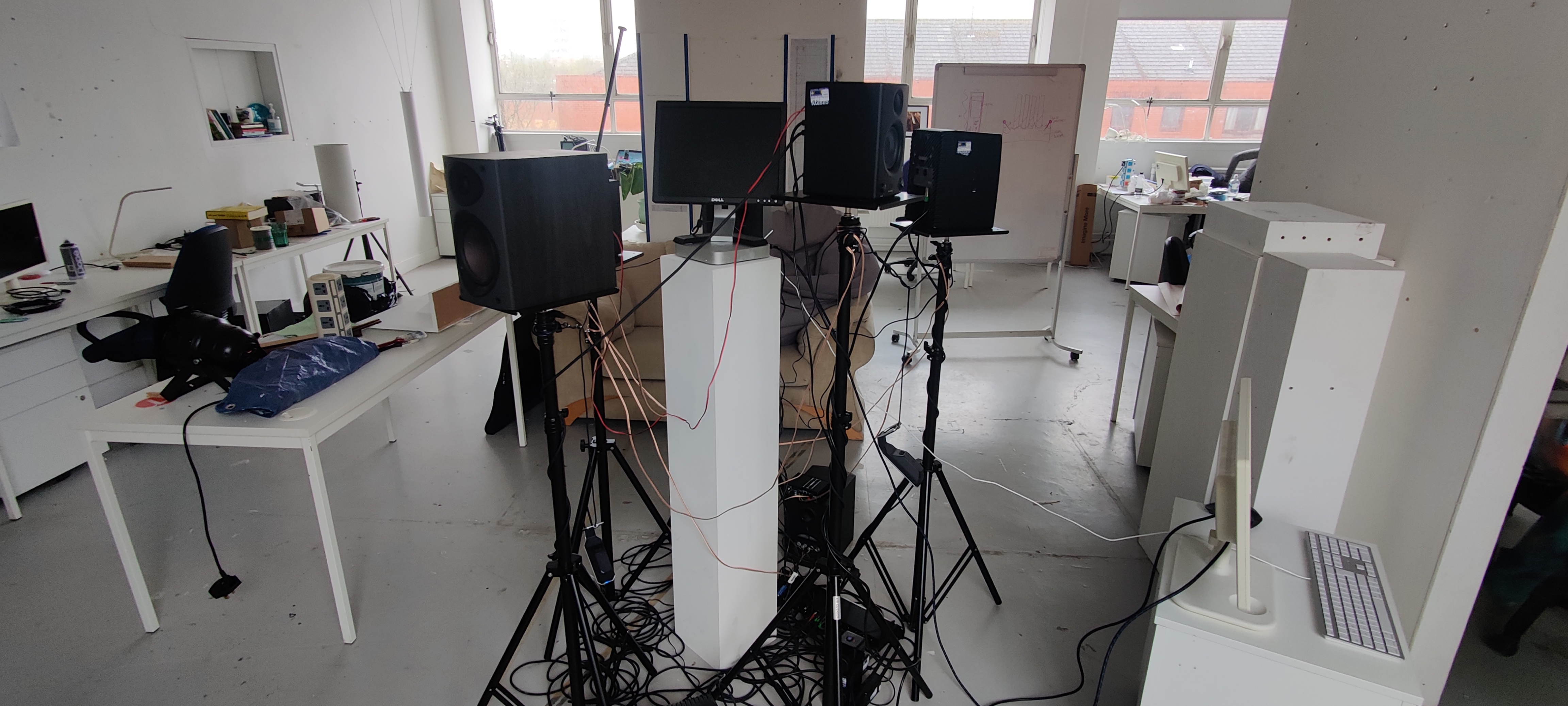

I am really happy with the setup of this. I used the speaker wire as hanging at the top, and the speaker cables below as sort of floor foliage. I hung the two desktop speakers off wire, I do quite like it, but I am not sure if it looks tacky or not. I am very happy with the look of it.
Painting and Photography
I painted the plinth I used, giving it a couple new coats of white paint to smoothen out the scuffs.
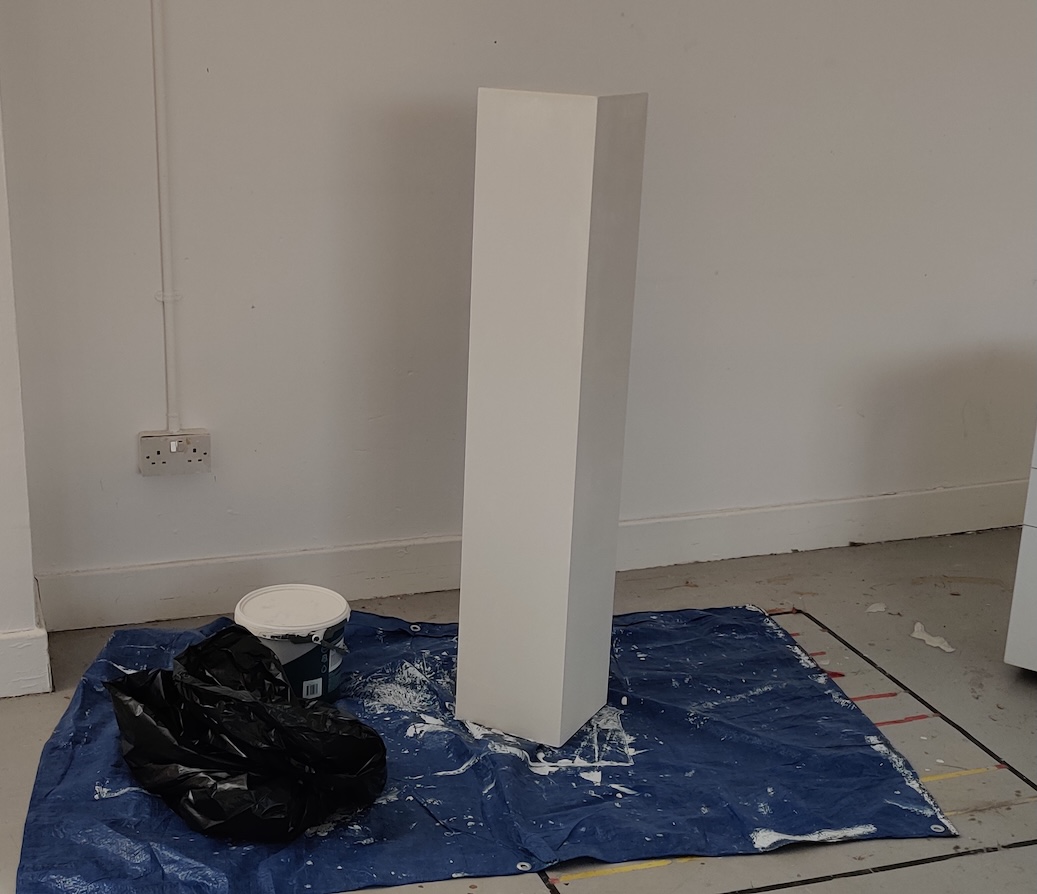
I want to dedicate a day to setting up my project in the Garage Space and take photos and recordings of it for this learning journal and the video. The walls are quite scuffed in the Garage, but I figured I will put it in the center of the Garage so the walls won’t be that in focus anyway. I can paint over anything glaringly distracting. I could even focus the installation so that the background is slightly blurry.
Getting into words what my project is about
I think I am pretty much almost happy with the work. I just want to add a few more recordings, add some tweaks and alter the node visuals. I am currently focusing on what I am going to write in the video. More so, getting a grasp of the context around my work. A lot of it is mixed up in my head and I need to get it down into legible words.
Transcribing discussion
I called my Mum (as I often find it easier to figure stuff out with others!) and recorded the conversation. Transcribing it and putting it into ChatGPT to help me organise my words, I got quite good response with bits I can pick out and explain further in my own words with more nuance. As you can probably see, the response is still very ChatGPTy but it did help.
**Speakers may not be accurate.**
[Ally]
Um, once you start recording, it's like, oh, bloody hell, they're recording me. Um, I don't know. I suppose I should start, maybe I'll start with what I think my current, like, my final project's about.
[Mum]
Um... So, do you talk about what it's about, and then you can go back as to how you got to that place, maybe?
[Ally]
Yeah. So... How do I start?
[Mum]
What's your main objective of... Of this? What's...
[Ally]
I suppose it was to... Showcase, um... Different, like, sonic textures.
Where the... Like, with a lot of variation in the sort of, like, um... I don't know, it's kind of a mix of...
So, when I was reading the essay, um... I was quite interested in sort of... There was an essay about...
Kind of... Ultra-realistic field recordings, and how that can kind of contribute badly. To the sound, um...
I guess to the view of... The sound, and the view of sounds really makes sense, but... Like, for example...
[Mum]
That perception of sound.
[Ally]
Like, you might get, like, a, um... A relaxing CD of bird sounds and waterfalls, and like... The sort of...
So it's hyper-realistic in the terms of, like... The trying to make it... Sound like reality by kind of...
Bringing out the things, like, the bird sounds and the... Waterfalls, like, kind of... Editing it in such a way that...
It's not realistic. Like, the only realistic version of it. Like, it can't be realistic at all, because...
When you listen to it, it's a reproduction of... It's an attempted reproduction at the thing that is... Like, there's someone that records it that has character.
And the thing that plays it back, that has character. So it's not the same.
[Mum]
Yeah.
[Ally]
But it was still... Like, the data that runs, it was obviously captured by the sound in the original place. Like, it'll never be the same.
[Mum]
And you also got things like... Like, other things, like... That, oh, don't have sound, but that can affect it, like, the wind movement.
[Ally]
Yeah, like... Maybe people with different microphones will put different, like, wind guards on. Like, you know, the big fluffy things on microphones.
[Mum]
So you were interested in that particular...
[Ally]
Yeah, so I sort of... And there was another essay by the same person that was kind of exploring sound as a material. So if you kind of think about, okay, so...
You can kind of see... If you play back... So I collected a bunch of random audio recordings online.
Lots of different microphones, lots of different locations. I assume a lot of different intents of what they wanted to achieve. And play it back through lots of different types of speakers.
So it's kind of... It's... It's kind of showcasing...
Yeah, it might not be... It's obviously not the sound that it says. Like, you're not hearing...
The... The children playing in, like, Brazilian favelas. You're hearing kind of a...
Not a twisted memory of it, but... Like a sort of, quote-unquote, reproduction. But it doesn't mean you can't kind of...
Admire the kind of textures the reproduction has made.
[Mum]
Yeah, it doesn't mean you can't enjoy it, or...
[Ally]
Yeah.
[Mum]
I suppose, in a way that any artist... Could you soon... I mean, look at a picture of Bangoff's...
...scenes in Set and the Southern Dance. And the colours are not like any colours that anybody would see.
[Ally]
Yeah.
[Mum]
The reproduction of his being quite extreme. But then the ones in between that were more like landscape artists that... ...tried to make things much more realistic is still not ever going to be. So I suppose...
[Ally]
So is an interpretation, I guess.
[Mum]
You could view recordings of sound... ...as different levels of that. Being a reproduction, some of which are...
...attempting to be nearer to the actual thing, but it's never going to be exactly the same.
[Ally]
I suppose it's like... I don't know... I'd say ten people draw the same scene they had, and it'd be slightly different.
Like... Maybe... You could draw parallels, like...
Maybe there'd be bolder colours, so it'd be like higher volume, or like... Like every speaker has... Well, there's some that try and like exactly mimic the data, but like...
There'll be more bass in some, or more highs, or more mids, which can... But then you also have the people observing it, which have another... Like...
The people that listen will... No-one's listened to the same, so it's kind of like... And they also wanted...
It's kind of... There's a lot to be appreciated in textures you might not usually... Like, sounds you might not usually listen to or think about much, like...
A great flipping... Like... When a car drives over it, or...
Or like... The hum of a... Um...
Of like industrial machines... Yeah... But like...
You've also got the... The air in between it, so you might like listen... There might be a recording of that from outside, so the wall also impacts it...
[Mum]
Mm-hmm...
[Ally]
And the... I don't know... I guess it's hard to say what I was trying to achieve in a simple...
[Mum]
I guess... I suppose at the beginning, you were not... You've had to focus, haven't you, down to this...
At the beginning, it was a wider interest that you had... And when you did your essay... Your dissertation, it...
Encompassed a lot of concepts, and stuff that you were reading... And then you've had to narrow it down to this...
[Ally]
Yeah... I think it...
[Mum]
The actual project...
[Ally]
Yeah, so it started with... A kind of continuation of the themes of more of a project, like... Um...
Enlightenment's not the right word, kind of... Being current... In different spaces, that was an exploration, like...
[Mum]
Do you mean by being current? Do you mean...
[Ally]
Present, I guess...
[Mum]
Walking the here and now, like... It's... Yeah...
[Ally]
Yeah, so... In... My CRT audio-visual piece of project...
Um... That was, like, words written while I was feeling present in different locations... Kind of like a...
A real-time journal of what I was experiencing almost... Yeah... And then there was...
The kind of clay project of... Um... A journey throughout Lockwinnock, and then there was...
Ooh... Then there was the... The zine poetry...
AR project that... Was, like... Writing and poetry written when I was, like, in a particularly...
Stressful theme, I guess... Um... So it all kind of links back to...
I guess it's just, like, the mind and the world you're in... Like, the perception of...
[Mum]
Yeah...
[Ally]
The world through my mind, but I kind of expanded... This project to be... It's less about...
So I haven't really... There is creative input, but... I'm not editing the sounds, I'm just playing them back sort of randomly, so people can...
And they're not even the sounds I've recorded, so it's... It's kind of...
[Mum]
So what you have to say, I suppose, is your reason for doing that, don't you? Like, why... You're not editing it...
It's not sheer laziness, it's because that's what you want...
[Ally]
Mmm...
[Mum]
The result to be an unedited version of it...
[Ally]
Yeah, I guess, like... There's also a consideration of how these sounds reach my ears, I guess... Maybe it's been recorded by...
Someone's gone out, they've recorded it with a microphone they have... Then they uploaded it, maybe they compressed it, or I don't know... It was checked, and then uploaded it to a site, and then...
It was downloaded...
[Mum]
And then... Just to get that process...
[Ally]
Yeah... But also...
[Mum]
Which could... Could that... Could that repeat...
Transfer to a natural situation? So if you went... Yesterday, Dad and I were walking...
We walked through the woods near Morgan... And there was... Loads of birds, like loads of different bird songs, I put my bird thingy on...
And there was about 8 to 10 different small bird noises... But then I was thinking... It sounded like...
So we have them in the garden as well... But it sounded really different in the woods... And it probably is an acknowledge thing, but it never occurred to me before that actually the birds probably used the trees as...
Things to bounce their sound off... Yeah... Because it sounded a bit echoey...
It was like this echo in the woods of... The bird song...
[Ally]
That was kind of like a... Another... Essay I read by the same person again...
Quite good essays... That... I think the...
The... The animal they use was a frog, but like... You're not hearing a frog...
Because it left the frog, it's... It's the frog like... Physically moved, it's I guess...
I don't know if they use the throat to make the noise, but then it came out... And then... Child through the air maybe...
Through the... Through leaves, maybe the wind kind of distorted or whatever...
[Mum]
Yeah...
[Ally]
And then it reaches you... And it's... It's not...
The sound of the frog... Like... I guess you could consider it from the frog...
[Mum]
Yeah, but I suppose this... The point as well is that each time... That frog could be sitting in the exact same place...
And push that noise out, and you... You could hear it differently every single time because of all the other...
[Ally]
Factors... Yeah...
[Mum]
That wind's play... Which... Could then say, well about the sounds that you've...
You've captured from, you know... You've acquired from wherever to put into your project... It doesn't matter that it's not come from a frog's mouth...
It's come from... Somewhere else... And each time somebody hears that...
They could hear it, you know... We could be standing next to each other and listen to the same thing... And hear it differently...
It doesn't matter that it's not in a pond with a frog in it... It could just be a piece of sound that's coming out of your installation...
[Ally]
Yeah... And like, no matter the... Origin of it...
Like, what you feel that sound represents...
[Mum]
Like...
[Ally]
There's still... A quality for it to be... Listened to...
As its own thing... Like, the sound as its own thing... Like...
You don't have to listen to it and imagine... You might imagine, but like... I don't know, I kind of made...
So my project kind of resembles like an ecosystem, sort of... Of speakers... Like wires hanging around, sort of like the innards...
Like the veins or maybe... Synapses or maybe like vines or... Trees or the heart...
[Mum]
Like any kind of different... Natural system...
[Ally]
Yeah... And then since each speaker's different as well... It plays into the idea of...
It's not... I don't know how to word it... They have their own...
The sound you hear... Is distorted through different voices... Almost like people retelling a...
A story, I guess... I guess it is like a story, like... You retell a story that you...
Heard from someone else...
[Mum]
Yeah... Do the sounds... Or come out...
Together, is there any competition between the sounds?
[Ally]
No, so... It's kind of like, as if it's chatting... So there's the...
Maybe like... 8 different, 10 different speakers... In the programme, you can see it on the screen...
It's a node, kind of... There's lots of different kind of travellers...
[Mum]
Yeah...
[Ally]
Almost like electrical signals, so it might hit one speaker... And it... Has a sample, and it has a certain location in it, so it might go like...
Like it might be... The sound of... A frog riveting...
And then it might travel to the next one... And it will be a frog riveting again, but it'll be a different speaker, and it'll also be... Slightly changed, so it might be...
A second after, or a second before... It kind of explores the textures... Throughout, and then...
It can change what sound file it has, so it might be... It might have a frog, and then it might be like... I don't know, a preacher in Nottingham...
Talking about a god, but it might like, focus on one like... Word, or like, partway through a word, or... Kind of exploring the...
It doesn't explore it, like it does, but it... I kind of say is it lets other people explore it, so it kind of showcases it... So I felt like it was a fine line between...
What I want to accomplish, and my creative input... So I've decided... The programme of when to play...
The sounds, and how to play them... I even selected like, quote unquote, random twenty second sections of sound files... No...
Then you kind of just let it do its thing, and... I couldn't predict it, but it is quite effective...
[Mum]
Yeah...
[Ally]
Exploring different textures, like... People... Objects...
Machines...
[Mum]
Lots of different types of...
[Ally]
Yeah, weather...
[Mum]
Sound sources...
[Ally]
Yeah, weather, or... Pack of howling... Wolves, I don't know...
I guess it's kind of like a big... It's... There's no focus on what sounds it should play, like I haven't picked...
Oh, I'm going to just play animal sounds, or... I've tried to keep it varied from like... Any...
Like a lot of different various...
[Mum]
Yeah, in most places you're going to hear that mixture of sounds, aren't you? So again, yesterday when we were in the... Woods, there was all those bird noises, there was me and Dad's feet footsteps, then you could start to hear the motorway in the background as we got near it to it...
Then there's this group of lads all... On the bikes, shouting to each other... Yeah...
You do have like, lots of mechanical sounds, don't you, in between...
[Ally]
You can focus in almost... I'm still trying to struggle how I say what my projects... About...
[Mum]
What's the title of? Have you got a title?
[Ally]
So the title is An Array of Floating Ears... Because that kind of imagined... I guess a bunch of ghostly floating ears...
Covering the whole world, and it just like... Picking one at random, and like listening to what it is...
[Mum]
So yeah, I don't know what else... Because it sounds like you know... You know what the aim of what the project is, and what it's about, and what your intentions are with it...
So it sounds like you know where it came from, like how you got to that place... And what else do you have to say? Do you need to say...
How long is this... Do you not know how long this thing's going to be?
[Ally]
Probably two, three minutes... I mean there'll be images as well, it won't be constant.
[Mum]
And I suppose what you want to say is what you'd like the observer to... What you'd like them to... I don't know, do you say what you'd like them to gain out of it, or what you'd like them to experience?
So whether it's... Do you want them to just enjoy... Because I guess it's going to be quite a mindful experience, isn't it?
Or do you want them to think more deeply about... I don't know... Or would you want them to just make their own...
You know, some people will come to the conclusions on their own, won't they?
[Ally]
Yeah, I mean that's what I'd want. I guess I have to be kind of... Like, say my intentions, but also if someone...
If people ask, then it's kind of like a brief thing, so it's... It's the exploration of... Maybe it allows you to explore different sonic textures from the different characteristics of the speakers, I don't know.
[Mum]
Or maybe some sort of awareness. It doesn't have to be understanding, does it? It doesn't have to be understanding.
You don't have to appreciate it, because that's appreciated in the eyes of the beholder, doesn't it? But maybe to try and realise or see that these pieces of sound almost got their own... What did you call it?
We know when you said anything about sound being a thing and an entity.
[Ally]
Is its own...
[Mum]
Each piece of sound has its own characteristics and behaviours and interactions with other pieces of sound. But you're not overlapping them, are you?
[Ally]
Yeah. Maybe I would even... Maybe an array of floating ears.
Maybe it should be from an array of floating ears.
[Mum]
Is it from the ears? Is it not, or... What are the ears?
Are the ears the people that are listening?
[Ally]
No, well, it could be, but I interpreted it as the ears of the microphones that initially recorded it.
[Mum]
Okay.
[Ally]
We're kind of playing audio from them, so maybe it's from an array of floating ears.
[Mum]
You don't want to be explaining too much from the point of view of the philosophical artistic side, because that's not what artists do, is it? But maybe it is more about how you got to that point of wanting to do that and the technical side of it. Is that not...
Do you need to put that in? Like, how you did it? Because, you know, all the artists might, but what medium they use, what paint they use?
[Ally]
Well, it'll be... I don't think I'll be hiding any of the electronics, because that's kind of a feature.
[Mum]
Yeah, but so you could say that, you know, as the audience will appreciate or will see, part of the display is playing bare, all of the... And the workings and the... And that was your intention.
That was your intention to be able to see that. I mean, do you need to put any more technical, you know, like, does it just get too technical if you start to...
[Ally]
I mean, I can easily describe the technical thing in a video, but like, if I'm doing like a description, like, you know, the art info, got the name and the title and the information. I don't think I'd leave it very bare on the technical things, because, like, you can kind of see that.
[Mum]
I'm just trying to think, like, how other people... Have you looked at other people's, you know, from past years, other people's videos, what they've done?
[Ally]
I have. I can send you it as well if you want. So a lot of people's were quite abstract, but it also stemmed from...
I think a couple stemmed from trauma or, like, loss.
[Mum]
So they're going deeper into why they've done it.
[Ally]
REDACTED
[Speaker 1]
...presentation, so that's all they, well they said more than that bit, otherwise... It's hard to know what, because I guess you put more deep stuff in your learning journal, don't you? Yeah, it's hard to strike a balance.
Yeah, I mean do you think it's all kind of, do you think, you know, if you go back and pinpoint this to the very start, do you think it comes from when you enjoy, you've enjoyed walking on your own in places like, you know, in Lock, what's it called? I think it is. Or, you know, when you were in the Lake District and you were on your own and just taking in, observing what's around you and then it starts to become that you're interested in sounds and...
Yeah, I'm trying to find the original thing I showed. So two things that match, like original things I wanted to explore was like, analyse the relationship between silence and sound and how each enhances our experience of presence, or what does presence mean in sound? And then a DHT tutor kind of guided it from there.
So yeah, so your original thoughts were that you were kind of identifying sound's place in the universe, I suppose, and... Yeah, I suppose that's a good... Because...
I guess it's our... Sound and sound. Yeah.
Because I guess, you know, you've got like, you sound and then silence, sound and silence and then sound and silence and each bits of those sound are like pieces of something, aren't they? Silence is void, isn't it, in a way? Yeah.
I guess we never... Because the point punctuates the sound. Yeah, I suppose that's a...
I mean, I guess I've been referring to these sounds as like singular, but you can also kind of see sounds as just like a continuous three-dimensional space garden. How can it be three-dimensional? I don't understand that.
So this is where the kind of floating ears came from, like, imagine an infinite amount of ears kind of in a three-dimensional, like around the world in three dimensions, like there'll always be something to hear at each one of those spots. You can kind of see it as like a three-dimensional web of ebb and flows of vibrations. Yeah, yeah.
And I suppose you've got an ear at one end of a city and then an ear at another end of a city, they're going to hear the same sounds but in different points of view. Yeah, maybe one has a sensitivity to sharp, grating chalkboard sounds, I don't know. Drills or dab scraping bowl sounds.
I was also trying to find, I couldn't find anything, but I was like, early on I was googling, okay, so if sound is just vibration, do we only consider a sound a sound if we can hear it? Like, is an earthquake not just a big sound? You can hear earthquakes, like the effect of it, but is like, I don't know, because if all vibrations are sounds, like if all sounds are vibrations, then why aren't all vibrations considered sounds?
Is it just the human perspective, like it's only important if we only consider a sound if we can hear it? Yeah. What's that?
It's like your lavender bag. Yeah. Nice.
So, I suppose I should maybe transcribe. Yeah, so if somebody, if you were in your degree show and somebody came up to you and just said, oh, this looks interesting, can you tell me what it's about? I suppose you need to know in clear terms what your answer to that is.
You don't have to say a lot, do you? You can't start waffling, can you? But you've got to know.
[Speaker 2]
Yeah, you can't just be like, uh.
[Speaker 1]
Kind of, sort of. You have to have an answer, don't you? And even if the answer is quite very short, and, you know, one of the things I'd like to do is for the audience to some extent to make their own mind up about what they're sensing.
Yeah. You know, but be really clear about that. You know, it's.
Yeah. I think it might be, you know, some people might want to know the technicalities of it, like what are all these wires and speakers and, you know, why have you set it up like this?
[Speaker 2]
Yeah.
[Speaker 1]
So you need to know an answer to the technical side of those things, don't you? But then you also want an answer to any more, you know, philosophical questions or just questions about what the art is depicting.
[Speaker 2]
Yeah.
[Speaker 1]
But it doesn't need to be complicated, does it? You don't need to. You could just say I've had a keen interest in sound and read a few essays as part of my dissertation earlier on this year that really interested me.
So I've started, you know, I've collected pieces of sound and I'm trying to present them in a way that, and then you explain, you know, what that's about.
[Speaker 2]
Yeah.
[Speaker 1]
I mean, there might be people that, a lot of people will just come and look at things, don't they? There might be people that want to know more, like dig deep more, in which case you, I guess you decide in advance how much of your soul you want to bear, don't you?
[Speaker 2]
Yeah.
[Speaker 1]
That's part of the thing. You don't have to justify to anybody the real depths of feeling about it, but if you want to, you can, that's fine. Yeah.
Once I get this video done, it'll help. I'll be able to like, kind of, just say what I said in the video, I suppose.
[Speaker 2]
Yeah.
Project Summary – From an Array of Floating Ears
This project is an exploration of sonic textures, perception, and the unreliability of reproduced sound. Drawing from essays on hyperrealistic field recordings and the materiality of sound, it presents a dynamic sound installation composed of audio gathered from a wide range of sources — each recorded by different people, in different environments, using different equipment.
The sound is played through a scattered ecosystem of varied speakers, each with its own sonic character. The result is a living, shifting soundscape — not a realistic reproduction of a moment or place, but a layered reinterpretation, filtered through machines, space, and human intent.
Rather than editing the audio, the piece emphasizes how sound changes through every step of its journey: from the microphone that first captured it, to compression and upload, download, playback, and finally, the listener’s own perception. The technical elements — wires, speakers, exposed systems — are intentionally visible, forming part of the artwork's “organism” and reinforcing the idea that sound is never neutral or isolated.
_From an Array of Floating Ears_ imagines an invisible network of listening points — a three-dimensional web of ears scattered across the world, each absorbing fragments of lived experience. It invites the audience to simply listen. Not to search for meaning, but to notice. To consider sound as presence, and presence as layered, unstable, and rich with texture.
Video Script: _From an Array of Floating Ears_
_(Soft ambient sounds fade in — maybe fragments from the installation)_
[Ally – Voiceover]
When we listen to a sound recording, we’re not hearing a place.
We’re hearing a version of it — filtered through a microphone, shaped by wind, compressed by software, and played back through a speaker with its own personality.
This project, _From an Array of Floating Ears_, is a sound installation made up of recordings I didn’t make.
Instead, I collected audio from many sources — online archives, forgotten uploads, distant environments — each captured with different microphones, intentions, and contexts.
These fragments are played through an ecosystem of mismatched speakers.
The wires are visible. The signals travel between nodes.
It feels like a network — a kind of synthetic organism, or a web of ears, scattered and listening.
The sounds shift and move — never the same twice.
A frog’s croak. A preacher’s voice. The hum of machinery. A distant conversation.
Each speaker adds its own colour. Like someone else retelling a story they once heard.
The idea came from reading about hyperrealism in field recordings — how attempts to make things sound more “real” can actually flatten their depth.
And from essays that treated sound not just as something to hear, but as a material — something you can shape, hold, question.
There’s no narrative here. No beginning or end. Just textures. Vibrations.
I’m not trying to say something specific. I’m offering a space to listen — to let your mind wander, to hear sound as it is, and as it isn’t.
It’s not about accuracy.
It’s about perception, distortion, and the beauty of imperfection.
Further exploration with notes
I started to write to try and formulate my thoughts and ideas into something people could understand.
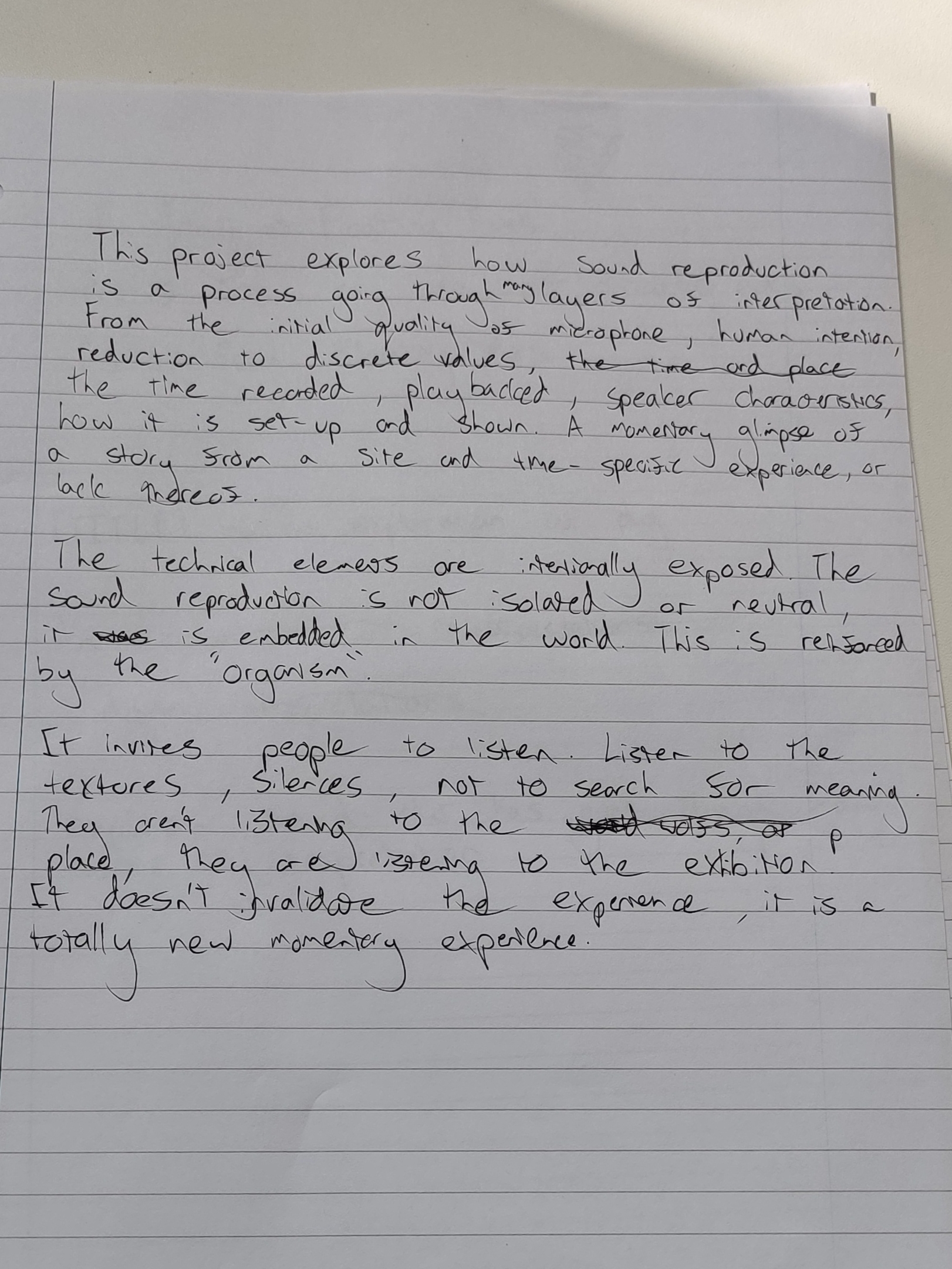
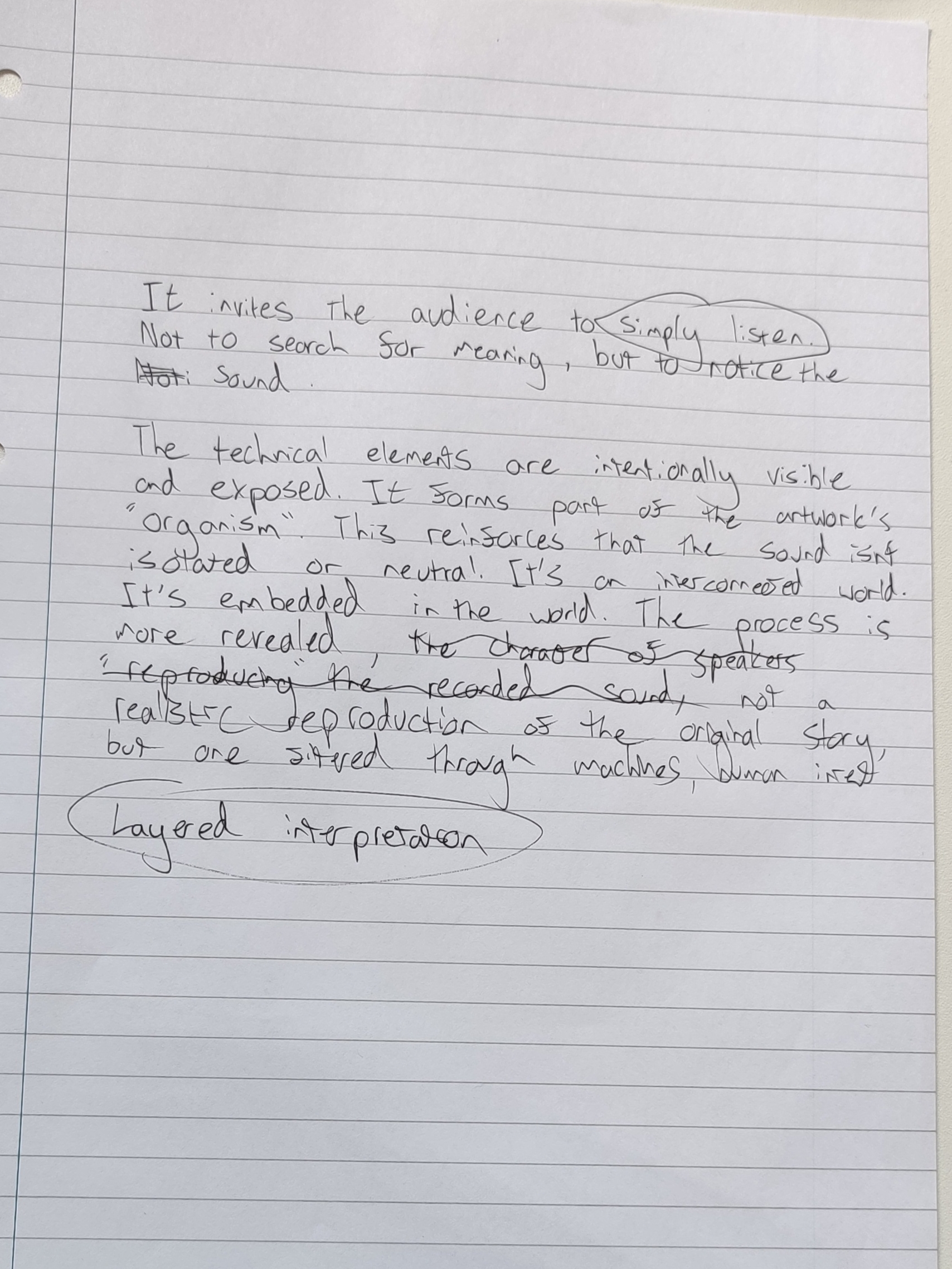
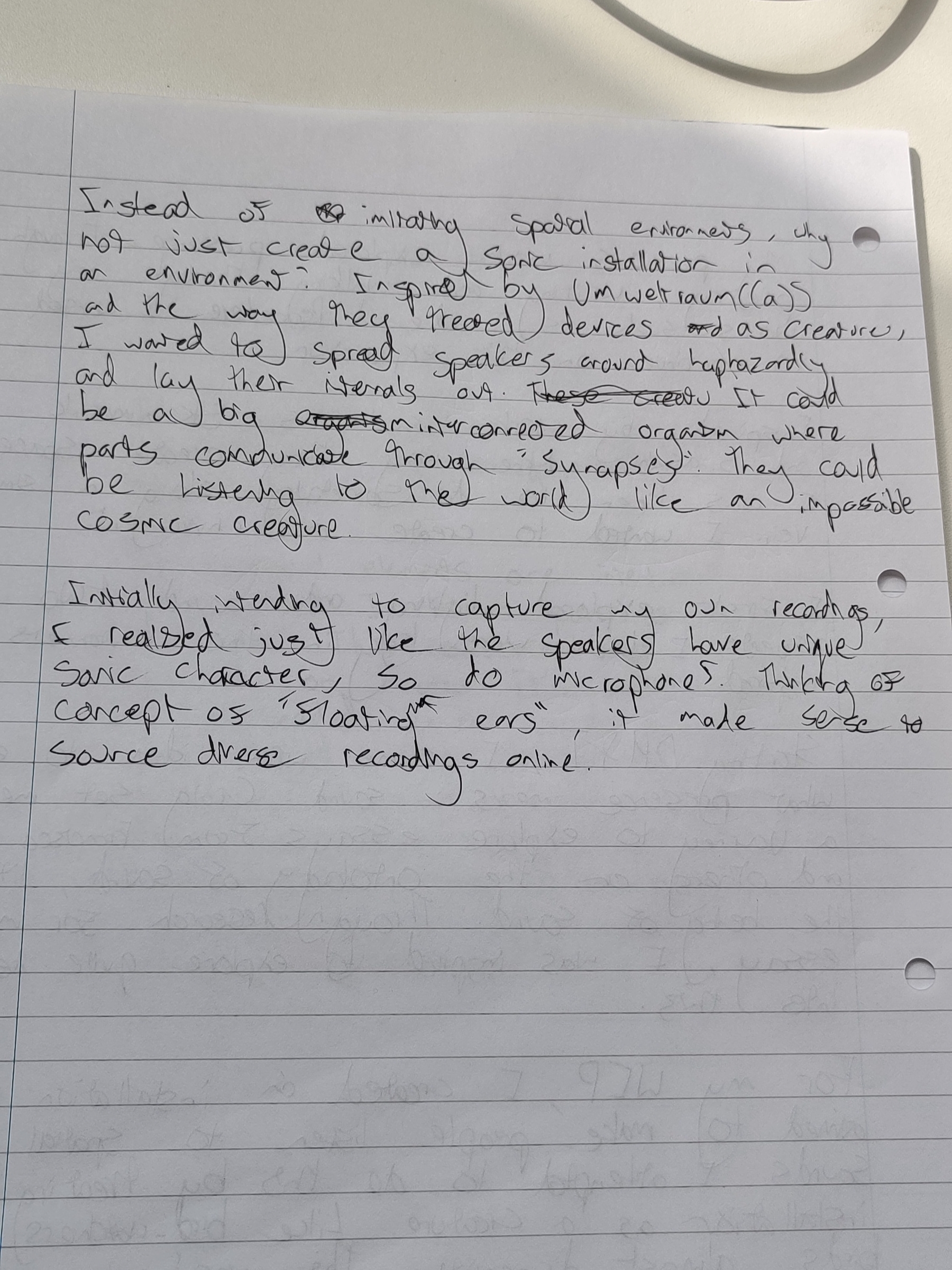

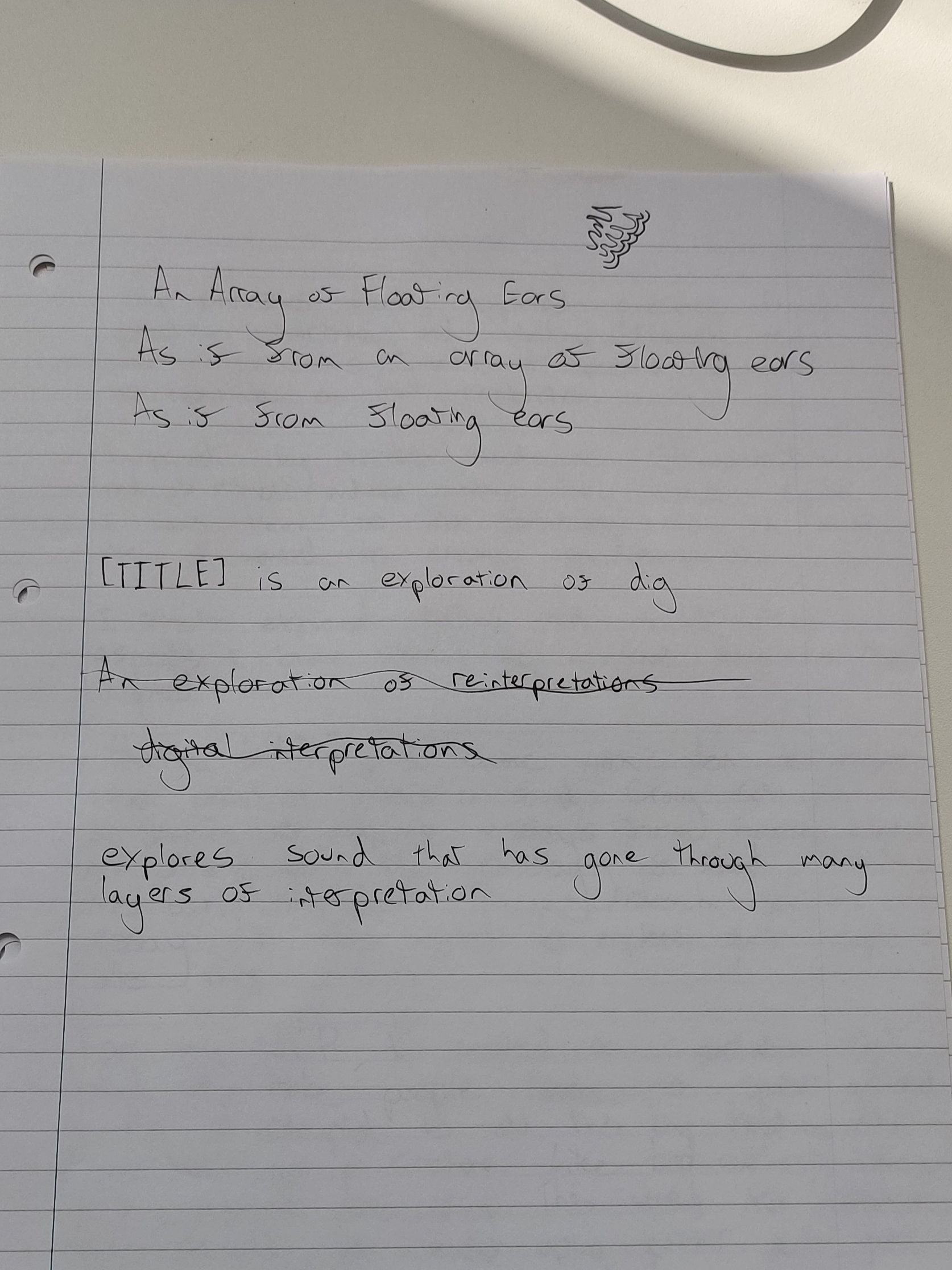

This project aims to explore the myriad of sonic textures in our world and the processes in which sound goes through. The innards of the system are exposed, reinforcing the fact that sound is never neutral or isolated. Through initial human intent to microphone character and the reduction of sound into discrete data and out again, there are so many layers of interpretation it goes through before reaching our ears. Our own unique umwelt the final layer in our experience.
You're not hearing a place, you are hearing an interpretation of it. I invite you to listen, seek meaning if you wish, but, simply notice the sound.
I feel I am getting closer to something that I feel describes my project that isn’t needlessly waffley or wordy.
(Video) Documentation
On Monday, since the Garage was free, I set up my project in there and captured documentation of it. It was a fairly exhausting process lugging everything up and down in one day, but it was worth it. I used my camera to capture videos and images of the work and also my Zoom H1N. I clapped in both so I could sync them the video and audio if needed.
The adapter Cat suggested to use, the Amazon basic USB to VGA, worked perfectly.
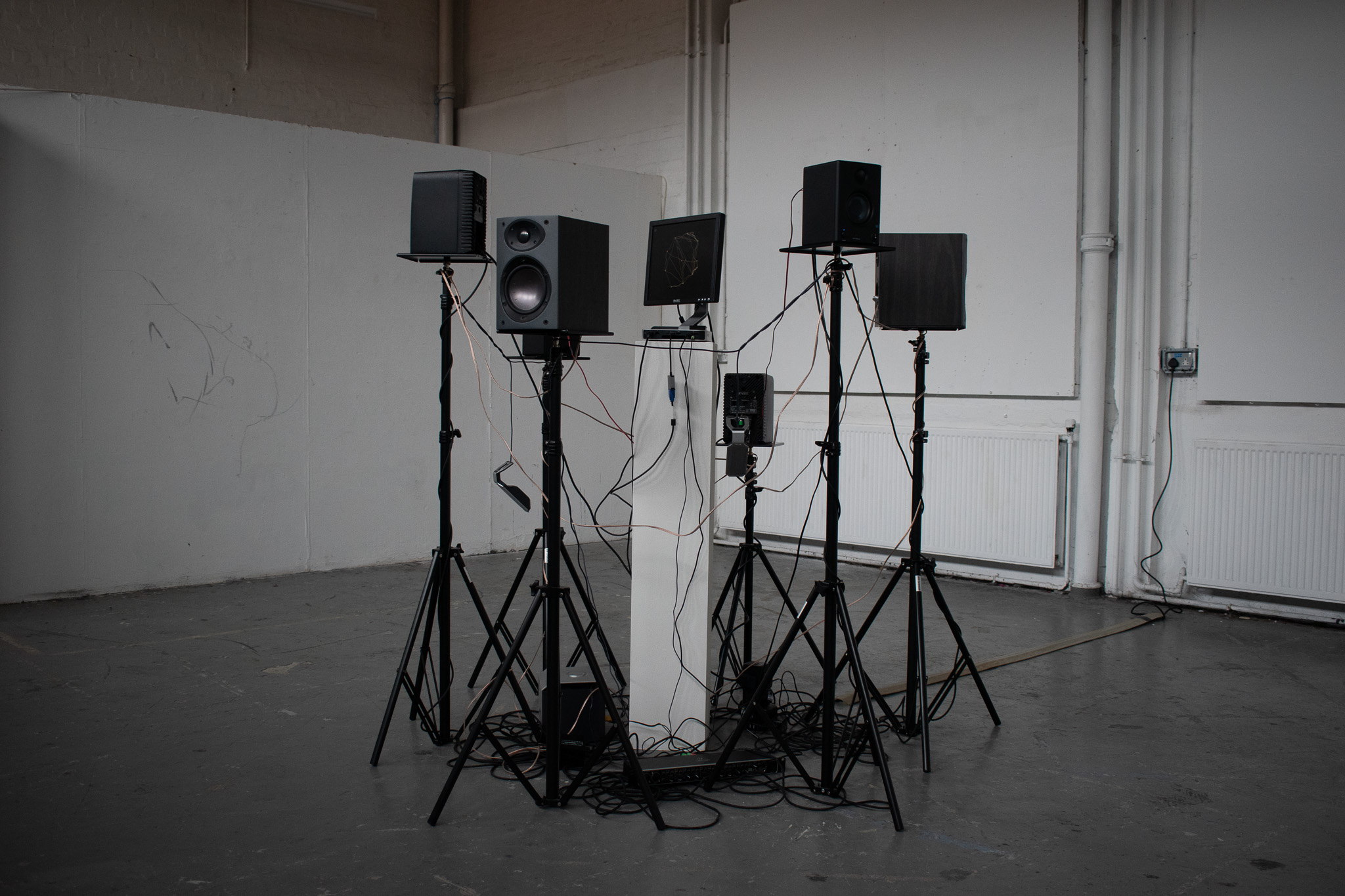
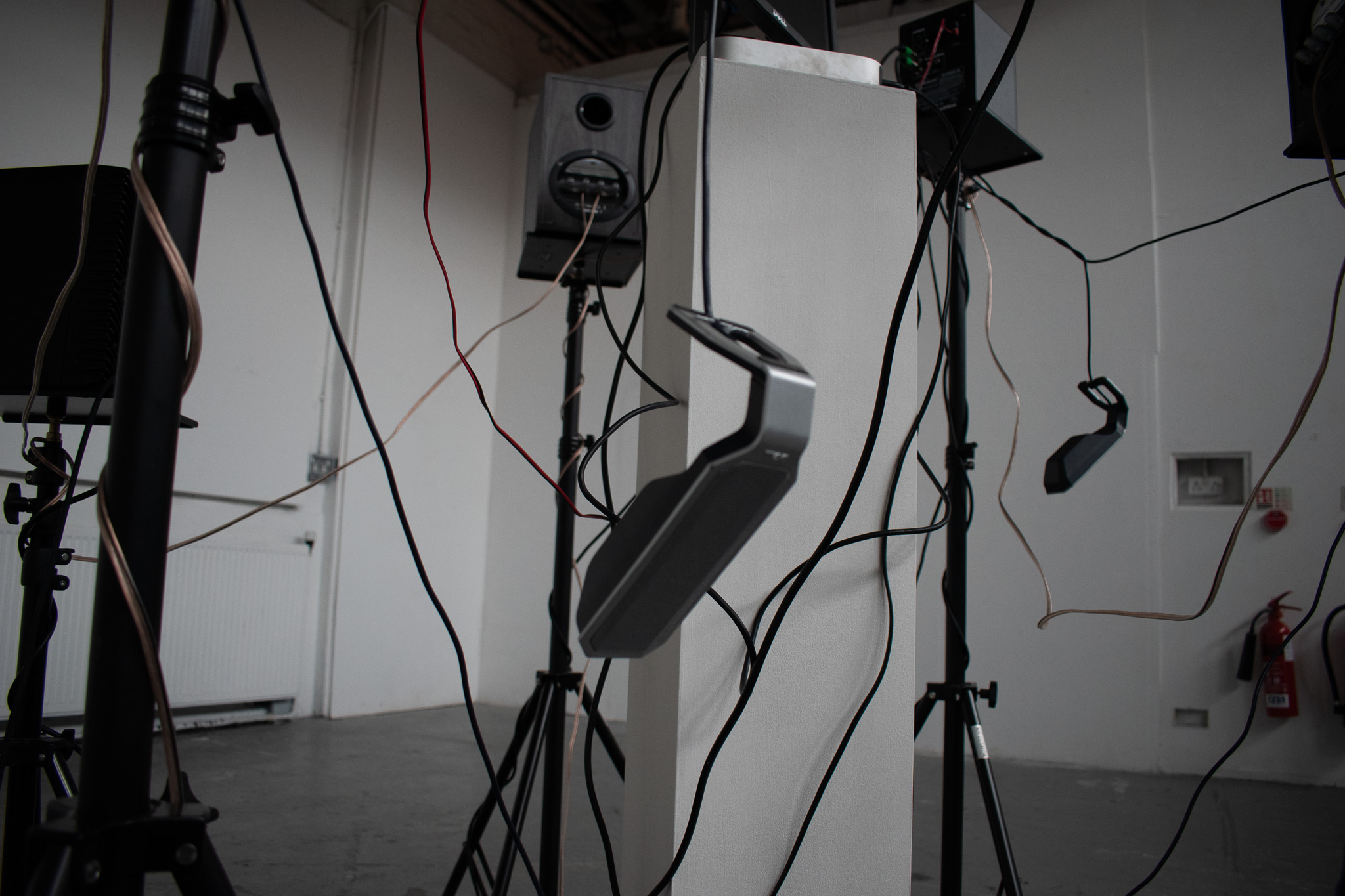

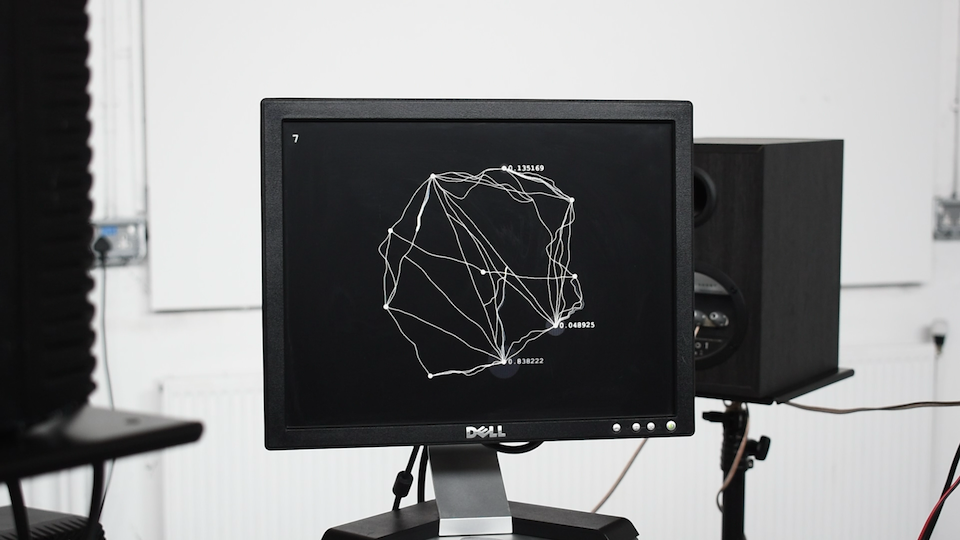
I am now working on compiling it all into video documentation for the submission.
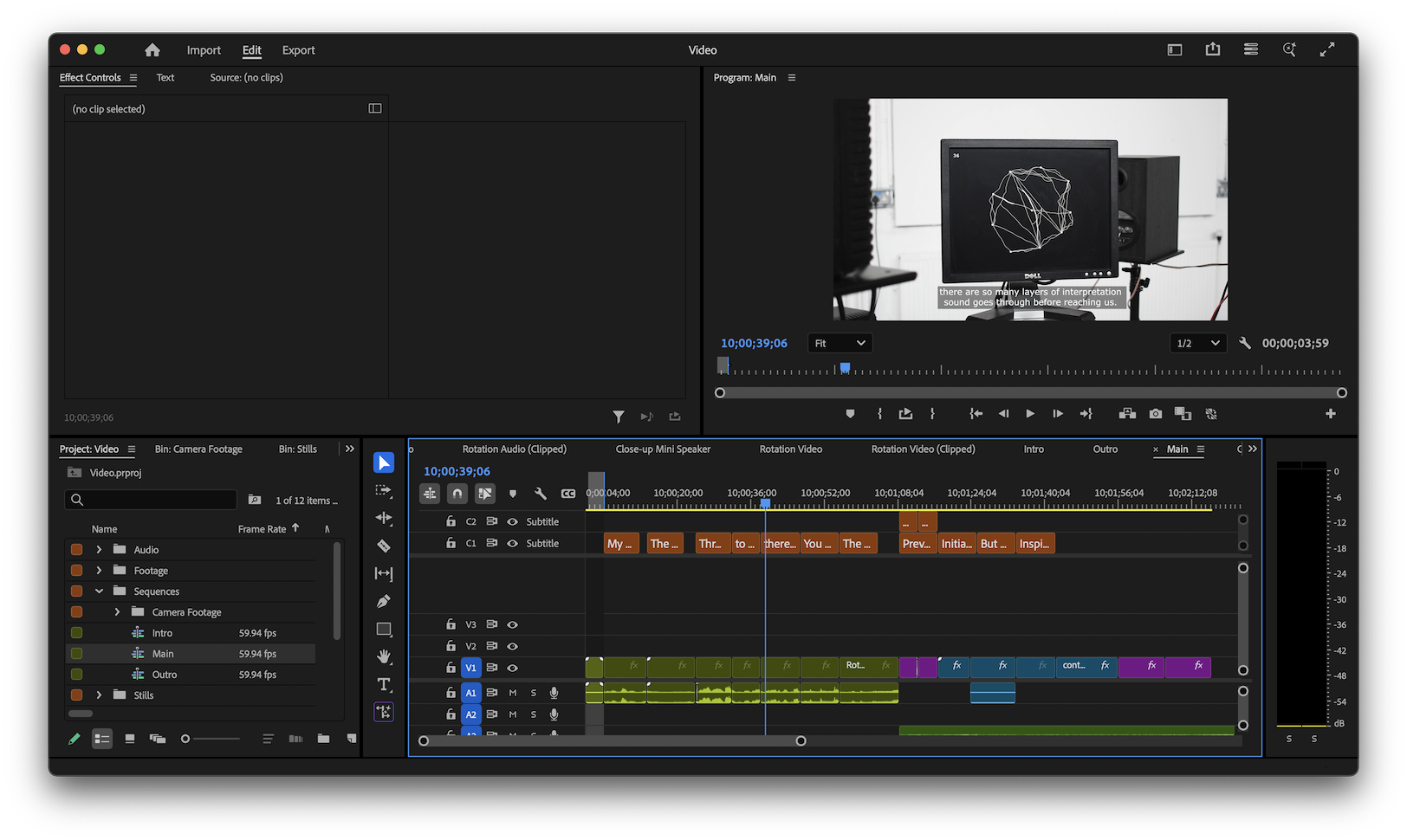
Submission Video
I talked about it and showed it to peers to get their feedback. The caption pacing and wording was adjusted and made until it felt right.
Conclusion
I put my documentation into folders separated by journal entry and media. This is apart of the submission, along with this learning journal and the video. 🤞
May 2025